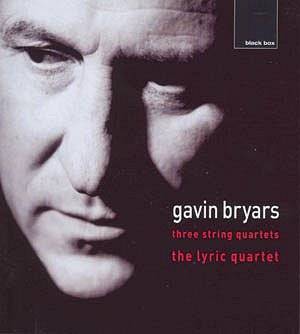Gavin Bryars began his musical career composing what
can be called ‘experimental music’, writing such pieces as The Sinking
of the Titanic and Jesus’ Blood Never Failed Me Yet, which,
while firmly rooted in minimalism, also owe a great deal to Bryars’
background as a jazz musician. Many of his early works focus on repetitious
elements, yet his later works have veered toward a more "classical"
sound.
Such is the case with these three string quartets.
Written over a period of some 13 years, they exhibit not only a growth
in the composer’s style within this genre, but an evolution in the depth
and texture of the music he has written for the string quartet. The
three are anchored in a very traditional, early 20th century string
quartet idiom, yet feature elements of Bryars’ familiar minimalist and
experimental sound.
The first quartet opens with an almost Glassian
section, with a great deal of tension building up as the piece progresses,
through chromaticisms and unexpected intervals. The pulsing rhythm that
underlies the beginning of this work is maintained throughout the first
section (there are no movements marked on the disc, though there are
clear delimitations within the music). The quartet continues through
a dense section, full of sawing riffs and waves of chords, before becoming
less structured, almost sounding improvised, and this section contains
an almost Bartókian beauty. The third section begins with a pulsing
rhythm, similar to the first part, with more melodic invention as it
develops. A fourth section, in which structure and rhythm are again
minimal, leads to a mysterious close.
The second quartet almost sounds like an extension
of the first, and, if one is not paying attention, one could think that
this is the case. The tone is similar to the end of the first quartet;
the atmosphere is just as mysterious.
The third quartet is darker and much more dense
than the first two, yet, at times, becomes more like a classical quartet,
with a familiar balance among the instruments. Brief sections appear
with pulsing rhythms, but these fade away to become more dramatic. This
work is much more of a classical quartet, and recalls, at times, works
by Beethoven and Haydn.
Bryars’ string quartets are challenging music, yet
not as much so as most "contemporary" classical music. The
composer’s origins in minimalism and his leaning towards melodic improvisation
give him the structure that keeps these works interesting and highly
listenable. This is not merely music written for its own sake, like
much contemporary music, but music with a clear direction.
While not a disc for everyone, these quartets are a
fine example of how contemporary classical music can be listenable and
highly accessible to those who do not appreciate much of what is currently
composed and performed.
Kirk McElhearn


